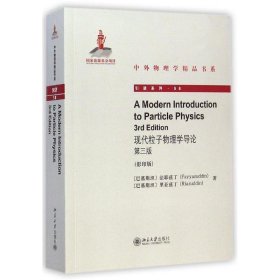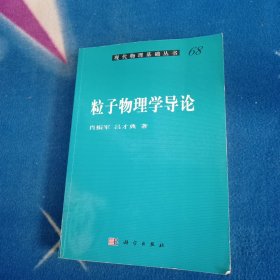
现代粒子物理学导论(第三版)(英文影印版) 英文原版书 (巴基斯坦)法耶兹丁//里亚兹丁
none
¥ 68.55 5.9折 ¥ 116 全新
仅1件
北京丰台
认证卖家担保交易快速发货售后保障
作者(巴基斯坦)法耶兹丁//里亚兹丁
出版社北京大学出版社
ISBN9787301251744
出版时间2014-12
版次1
装帧平装
开本16
页数657页
字数683千字
定价116元
货号xhwx_1201041627
上书时间2024-11-26
- 在售商品 暂无
- 平均发货时间 27小时
- 好评率 暂无
- 最新上架
商品详情
- 品相描述:全新
- 正版特价新书
- 商品描述
-
目录:
preface
1. introduction
1.1 fundamental forces
1.1.1 the gravitational force
1.1.2 the weak nuclear force
1.1.3 the electromagic force
1.1.4 the strong nuclear force 4
1.2 relative strength of four fundamental forces
1.3 range of the three basic forces
1.4 classi_cation of matter
1.5 strong color charges
1.6 fundamental role of \charges" in the uni_cation of forces
1.7 strong quark-quark force
1.8 grand uni_cation
1.9 units and notation
1.10 problems
1.11 references
2. scattering and particle interaction
2.1 introduction 23
2.2 kinematics of a scattering process
2.3 interaction picture
2.4 scattering matrix (s-matrix)
2.5 phase space 36
2.6 examples
2.6.1 two-body scattering
2.6.2 three-body decay
2.7 electromagic interaction
2.8 weak interaction
2.9 hadronic cross-section
2.10 problems
2.11 references
3. space-time symmetries
3.1 introduction
3.1.1 rotation and so(3) group
3.1.2 translation
3.1.3 lorentz group
3.2 invariance principle
3.2.1 u continuous
3.2.2 u is discrete (e.g. space reection)
3.3 parity
3.4 intrinsic parity
3.4.1 intrinsic parity of pion
3.5 parity constraints on s-matrix for hadronic reactions
3.5.1 scattering of spin 0 particles on spin 1/2 particles
3.5.2 decay of a spin 0+ particle into three spinless particles each having odd parity
3.6 time reversal
3.6.1 unitarity
3.6.2 reciprocity relation
3.7 applications
3.7.1 detailed balance principle
3.8 unitarity constraints
3.8.1 two-particle partial wave unitarity
3.9 problems
3.10 references
……
4. internal symmetries
5. unitary grou and su(3)
6. su(6) and quark model
7. color, gauge principle and quantum chromodynamics
8. heavy flavors
9. heavy quark e_ective theory
10. weak interaction
11. properties of weak hadronic currents and chiral symmetry
12. neutrino
13. electroweak unificatio
14. deep inelastic scattering
15. weak decays of heavy flavors
16. particle ming and cp-violation
17. grand uni_cation, supersymmetry and strings
18. cosmology and astroparticle physics
appendix a quantum field theory
index
内容简介:
本书涵盖了粒子物理各种方向,包括量子电动力学、夸模型、标准模型等等。在理论和实验两方面都进行了系统讲解。此外,本书还着重讨论了天体物理、宇宙学和粒子物理学的交研究,即天体粒子物理学。本书适合粒子物理、核物理、天体物理等领域的研究者和阅读。
相关推荐
— 没有更多了 —
























以下为对购买帮助不大的评价